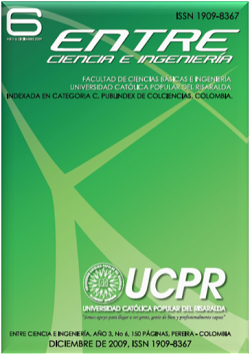Uso De Las Tics Y Objetos De Aprendizaje Para La Enseñanza De Las Matemáticas En La UCPR
Keywords:
technologies for communication and information, competences, didactics, learning theoriesAbstract
This article presents the development and implementation of an active strategy supported on the technologies for communication and information, which make it easier the teaching and learning process among teachers and students in the classroom. That strategy will be
focused specifically on those students who are taking mathematics courses in the different academic programs at Universidad Católica Popular del Risaralda. The main objective with this project is that the students improve their knowledge about this area and develop the minimal competences related to the subject.
As it is mentioned in the National Plan on technologies for communication and information, “the use of these technologies has changed the social customs and the way people interact. They have improved the opportunities for many people who were traditionally excluded, and the social mobility has been increased. These technologies have also changed the way people learn and the role of teachers and students. It has also demonstrated that the learning process cannot be measured in terms of time, it must be developed along the life of each person”.
It is important to remark that technologies for communication and information are a resource for the improvement of the teaching practice, but taking into consideration the human being. This is the reason why, the methodology proposed is based on the institutional ethic and
educative principles, looking forward pedagogic theory, pedagogical practice, and the use of technologies for communication and information applied for the teaching and learning process of mathematics, will contribute to get as a result, students who will become people, professionally and capable people.
References
Aymerich, JV y Vives Macario, S. (2006). MATEMÁTICAS PARA EL SIGLO XXI. Castelló de la Plana: Universidad Jaumé.
Barkley, E. y Cross. (2007) Técnicas de Aprendizaje Colaborativo. Madrid: Morata.
Batanero, C. (2001). Didáctica de la estadística. Granada: Servicio de Reprografía de la facultad de Ciencias.
Bowen, J. y Hobson, P. (2004). Teorias de la educacíon. Limusa
C, C., E, M., T, M., M, M., J, O., I, S., y otros. (2007) El constructivismo en el aula. Barcelona: GRAÓ.
Campos, HA (2005). Construcción de conocimiento en el proceso educativo. México
Comunicaciones, M. d. (Marzo de 2008). Colombiaplantic. Recuperado el 8 de noviembre de 2009, de http://www.colombiaplantic.org.co/medios/docs/PLAN_TIC_COLOMBIA.pdf
Dolores, C., Martínez, G., Farfán, R., Carrillo, C., López, I. y Navvaro, C. (2007). Matemática Educativa. México: Díaz Santos.
Garduño vera, R. (2005). Enseñanza virtual sobre la organización de recursos informativos digitales. México: UNAM.
Goméz Buendia, H. (1998). Educación: La agenda del siglo XXI. Santafé de Bogotá: PNUD y Tercer Mundo Editores.
González Ornelas, V. (2003). Estrategias de Enseñanza y Aprendizaje. México: Pax.
Gros, B. (2000). Ordenador invisible: El hacia la apropiación del ordenador en la ensenanza. Barcelona: Gedisa.
klenowski: Val. (2005) Desarrollo de Portafolios Para El Aprendizaje y la Evaluación. Madrid: NARCEA.
Krulik, S. y Reys, R. (1980). Resolución de problemas en matemáticas escolares. Reston: Anuario.
HOMBRES. (sf) Ministerio de Educación Nacional. Recuperado el 15 de noviembre de 2009, de http://www.mineducacion.gov.co
Miller, CD (2004). Matemática: Razonamiento y Aplicaciones (10a.Ed). México: Pearson.
Morales G, R. y Agüera H, AS (2002). Capacitación basada en objetos reusables de aprendizaje. Obtenido de http://www.umb.edu.co/umb/sitiopedagogia/lecturas/tendencias.pdf
Ortega, T. (2005). Conexiones matemáticas. Barcelona: Graó.
Prado Pérez, CD (2006). Precálculo: Enfoque de Resolución de Problemas (1a Ed). México: Pearson.
Rodríguez, O. y Francisca. (2001) Maemáticas: Estrategias de Enseñanza y Aprendizaje. México: Pax.
RUÉ, J. (2009). Aprendizaje Autónomo en la Educación Superior. Madrid: Narcea.
Samper De Zubiria, J. (1994). Los modelos pedagógicos. Santafé de Bogotá: Fundación Alberto Merani.
Spiegel, MR (1956). Teoría y problemas del álgebra universitaria (1a Ed). Estados Unidos de América: Schaum.
Vela Cano, AG y López Nieto, E. (2006). Programación didáctica y del aula. La Mancha: Universidad de Castilla.
Vélez de C, AM (sf). http://www.c5.cl/ieinvestiga/actas/ribie98/190M.html. Recuperado el 11 de noviembre de 2009, de http://www.c5.cl/ieinvestiga/actas/ribie98/190M.html: http://www.c5.cl/ieinvestiga/actas/ribie98/190M.html








 Revista Entre Ciencia e Ingeniería
Revista Entre Ciencia e Ingeniería .png) entrecei@ucp.edu.co
entrecei@ucp.edu.co.png) ISSN (Impreso) 1909-8367 - ISSN (En Línea) 2539-4169
ISSN (Impreso) 1909-8367 - ISSN (En Línea) 2539-4169 Attribution-NonCommercial 4.0 International (CC By-NC 4.0)
Attribution-NonCommercial 4.0 International (CC By-NC 4.0)
.png) Carrera 21 No. 49-95 Av. de las Américas, Pereira, Risaralda, Colombia
Carrera 21 No. 49-95 Av. de las Américas, Pereira, Risaralda, Colombia